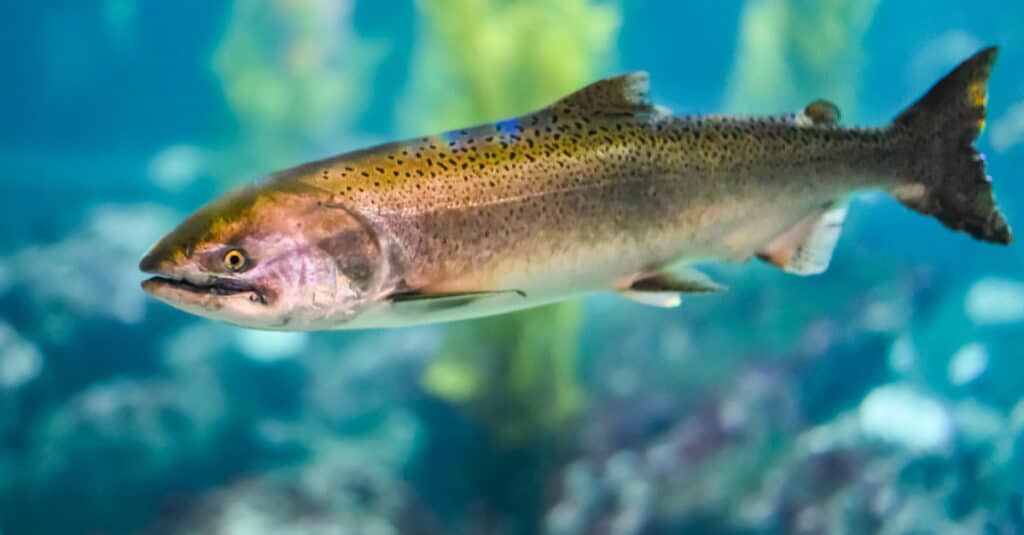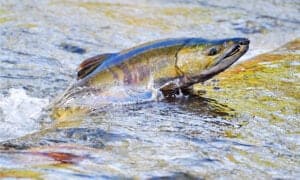
Salmon is an essential food source for many animals in Oregon.
©Konstantin Novikov/Shutterstock.com
108 species of fish swim in the waters of Oregon. Fish in Oregon provide nutritional substances to animals and humans. All fish are an essential part of the ecosystem and the food chain. They are a significant source of protein for humans, aquatic wildlife, birds, raccoons, river otters, and bears.
In Oregon, three fish species are essential for supporting aquatic wildlife and sustaining humans and other animals. Larger fish feed on smaller fish. Fish are considered predators because they eat smaller fish and other living animals. The overlooked benefit of fish in aquatic wildlife is the excrement they produce.
Fish excrement contains nutrients from the food they have eaten. The nutrients in the fish excrement are an essential fertilization product for aquatic plants and algae to grow. The aquatic plants and algae provide food and shelter to other fish species, maintaining a healthy balance for the aquatic ecosystem.
1) Chinook Salmon (Oncorhynchus tshawytscha)

The Chinook Salmon is the official state fish of Oregon.
©Evan Linnell/Shutterstock.com
Oregon’s state fish is the Chinook salmon. Of the seven major salmon species, two species are fish in Oregon and the chinooks grow to be the largest. They reach lengths of up to 58 inches and weigh 126 pounds. Because these salmon grow so large, they are named “king salmon.” Wild salmon are food sources for over 100 fish, birds, and mammal species.
Chinook salmon are essential fish in the Oregon ecosystem. A female will lay between 3,000 and 14,000 eggs in her river nest. The young salmon feed on insects and small crustaceans, providing a natural method of insect control. Young salmon become a primary food source for small animals, birds, and larger fish. After the juvenile fish reach the open ocean, their predators are significantly reduced.
Salmon will not live in polluted water. The presence of salmon ensures that the river or stream they are in is healthy. These fish recognize polluted waters through their sense of smell. If the salmon disappear from a river or stream, the living things that rely on them for food and nutrients will become endangered.
When the salmon leave the ocean to return to the freshwater to spawn, they do not eat. The fish can live for up to six months without eating. The main goal of the fish is to spawn, and after they spawn, they perish. The dead fish then add more nutrients to the water and provide food to a more significant number of animals.
2) Coho Salmon (Oncorhynchus kisutch)

Coho salmon are anadromous fish, meaning they live in fresh and saltwater.
©Keith Publicover/Shutterstock.com
The Coho salmon is the second salmon in Oregon that is essential to aquatic wildlife and humans. Coho salmon reach lengths of two feet and weigh 35 pounds. They have a lifespan of two to five years.
Coho salmon are called silver salmon because they have silver sides under green or metallic blue backs. However, when the fish are in fresh waters, their sides are dark red instead of silver. The males have large teeth, and their snouts are hooked.
These fish are essential to aquatic wildlife and ecosystems because they are a primary food source for otters, seals, and various fish species that feed upon the young coho. As the salmon grow larger, their primary predators also become larger. Adult coho salmon are a primary food source for sharks, sea lions, and orca whales.
Coho salmon are a healthy food choice for humans. The fish are naturally low in sodium. They also add omega-3 fatty acids, protein, niacin, and B12 to your diet. Nutritionists recommend consuming Pacific salmon like the coho for everyone, especially those fighting cardiovascular diseases and obesity.
3) Steelhead Trout (Oncorhynchus mykiss)

Steelhead trout are the anadromous variety of rainbow trout.
©David A Litman/Shutterstock.com
Like the chinook and coho salmon in Oregon, the steelhead trout is an anadromous fish species. Anadromous fish live in both freshwater and saltwater. Steelhead trout are also called steelhead salmon because they behave more like salmon than trout.
A steelhead trout is born in fast-flowing rivers. Like salmon, they migrate from the river’s freshwater to the saltwater of the ocean and grow to their mature size. When they are ready to spawn, they return to the river they were born in, just like salmon. Rainbow trout are the same species as steelhead; however, the rainbow trout is not anadromous.
Rainbow trout and steelheads are comparable in size. They grow to lengths of 45 inches and weigh more than 50 pounds. However, the average steelhead trout caught in Oregon weighs 8 pounds.
Steelhead trout are essential to wildlife and ecosystems because they provide a protein source for diverse wildlife. These fish are food sources for:
- larger fish
- eagles
- herons
- kingfishers
- Black Bears
- river otters
- raccoons
- humans
FAQs
What fish in Oregon is most popular with anglers?
Rainbow trout are the most popular fish with anglers in Oregon.
What time of year do salmon spawn in Oregon?
Pacific salmon, such as the chinook and coho, make their trip to spawn starting in May, and everything is over by the end of October. Near the end of the run, you can wade into the water and catch the salmon by hand. Be careful because where there are plenty of salmon, there are plenty of bears.
The photo featured at the top of this post is © Evan Linnell/Shutterstock.com
Thank you for reading! Have some feedback for us? Contact the AZ Animals editorial team.







